自1980 年前后甜樱桃开始在中国商业化栽培以来,其种植面积以每年15%~20%的速度在增长。据中国园艺学会樱桃分会统计,2020年甜樱桃在中国的种植面积和产量分别约为20万hm2和80万t[1],中国是甜樱桃种植规模较大的国家之一[2]。甜樱桃自1994年在青海省开始栽培,2000年后开始规模化种植,主要分布在海东市的乐都区[3]。近年来甜樱桃已发展成为青海省的特色水果产业。因青海省具有独特的气候资源,露地栽培的甜樱桃较内地其他地区晚熟,从而规避了供应高峰期,大大延长了鲜果的供应时间,因此具有较大的市场需求和良好的发展前景。
甜樱桃果实大、颜色艳丽、味道鲜美、营养丰富,深受消费者喜爱[4]。而水果风味包括口腔的感觉(甜、酸或苦)和香气物质的气味,在消费者的喜好中起着非常重要的作用[5]。糖和酸与消费者偏好有关,而香气物质决定了水果的独特味道[6]。随着生活水平的提高,人们对高品质水果的需求也在增加,具有诱人香气的水果会备受青睐[7]。如果水果品质退化,香气有所损失则会降低消费者的购买欲望[8]。目前水果香气的研究受到广泛关注[9-10]。Gonçalves等[11]报道,从23个甜樱桃品种中共鉴定出66种挥发物,包括16种醛类、23种醇类、6种酮类、6种酯类、8 种单萜、3 种异戊二烯类、2 种烃类和2 种酸类。Magri等[12]研究显示,从4个甜樱桃品种共鉴定出34种挥发性化合物,不同的香气物质与甜樱桃品种相关。果实香气组成与含量在不同发育阶段也明显不同。随着果实的成熟,香气物质成分和含量会不断发生变化,从而影响果实的香气程度[13]。张序等[14]研究显示,红灯甜樱桃的特征香气成分在着色期大量合成,在商熟期达到高峰,完熟期因出现大量乙醇导致风味变劣。Correia 等[15]报道,3-甲基-2-丁烯-1-醇和1-己醇(1-Hexanol)含量在甜樱桃成熟期间显著增加。田竹希等[16]研究显示,绿熟期相对含量最高的物质是醇类,着色期、商熟期和完熟期相对含量最高的均是醛类物质。醛类物质从绿熟期开始便持续不断合成,直至商熟期达到最高值,至完熟期时又略微下降。
Villavicencio 等[17]报道,甜樱桃的脂氧合酶(LOX)在成熟过程中的4 个发育阶段均有表达,共鉴定出13 个LOX 候选基因(6 个9-LOX 和7 个13-LOX)在甜樱桃中有差异表达,且表达量提高与挥发物含量呈正相关。随着果实的成熟,果实体内会发生极其复杂的生理生化代谢过程,挥发性香气化合物也随之改变。因此,发育时期是影响果实香气产生和积累的关键因素,果实发育过程中香气物质的变化成为近年来甜樱桃产业领域的研究热点。
笔者探讨甜樱桃品种莫莉(Moreau)、2018-13、塞莱斯特(Celeste)、2018-20、甜心(Sweetheart)、雷尼(Rainier)果实发育过程中香气物质的动态变化,旨在为甜樱桃香气物质的合成代谢与调控研究提供理论依据。
1 材料和方法
1.1 材料
甜樱桃品种莫莉、2018-13(斯坦勒自交后代)、塞莱斯特、2018-20(斯坦勒自交后代)、甜心、雷尼来源于青海省海东市乐都区农业示范园区(101°75 E,36°73 N)(表1,图1)。建园时树龄为2 a(年),至2024 年树龄为7 a。水培管理按当地常规方式进行。春季开花前常规修剪枝条,采果后常规修剪管理,666.7 m-2产量约为220 kg。株行距1.6 m×2.5 m,纺锤形树形。分别于2023年6月24日、6月25日、6月28日、7月1日、7月8日和7月10日采样。6个品种每个时期采集45 个果实作为试验材料,3 个果实为1次重复。在西北农林科技大学园艺学院实验室测定果实香气成分。
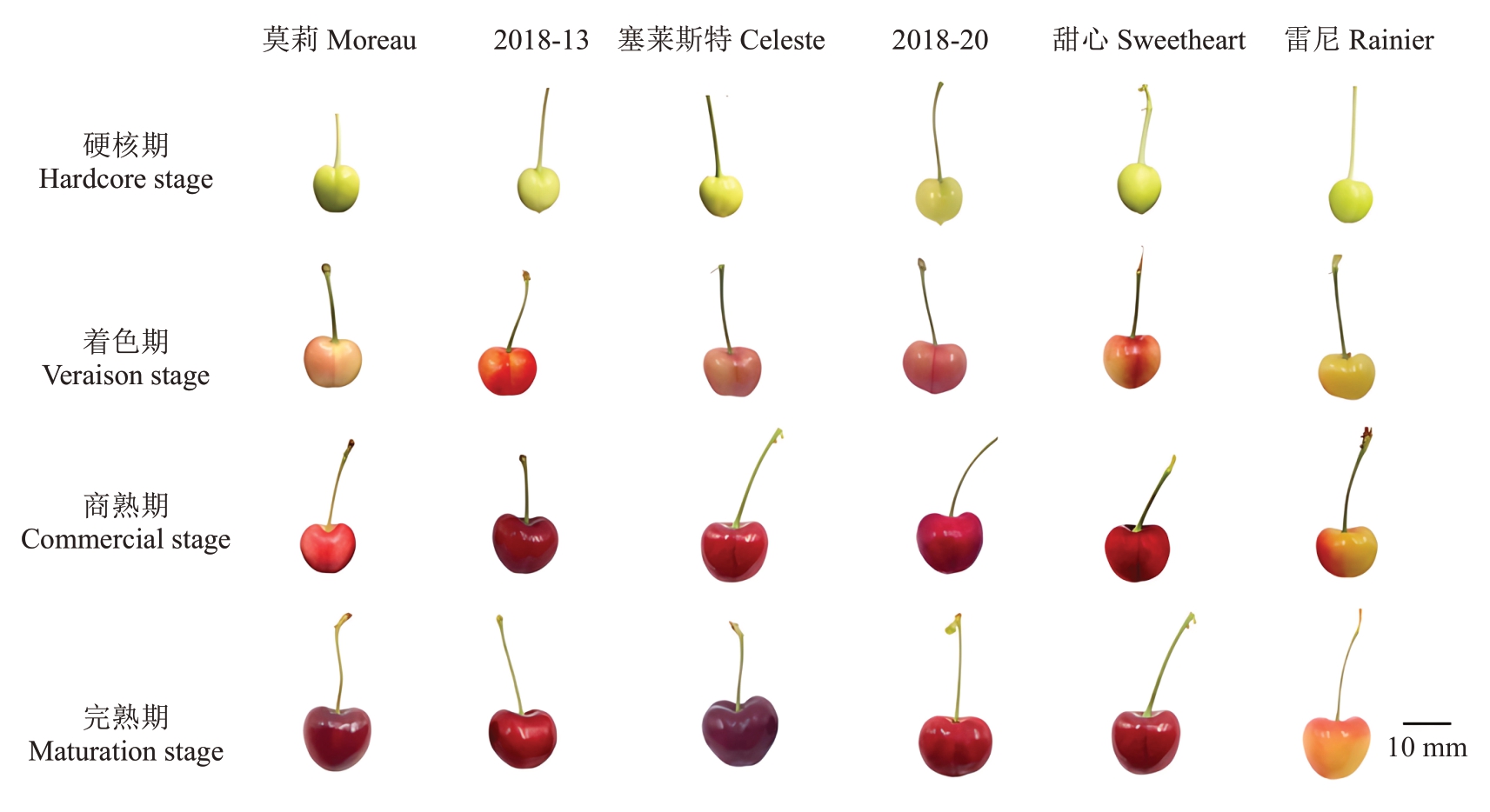
图1 供试6 个甜樱桃品种果实的外观
Fig.1 Appearance of 6 sweet cherry fruits tested
表1 供试6 个甜樱桃品种材料
Table 1 Materials of six sweet cherry varieties tested
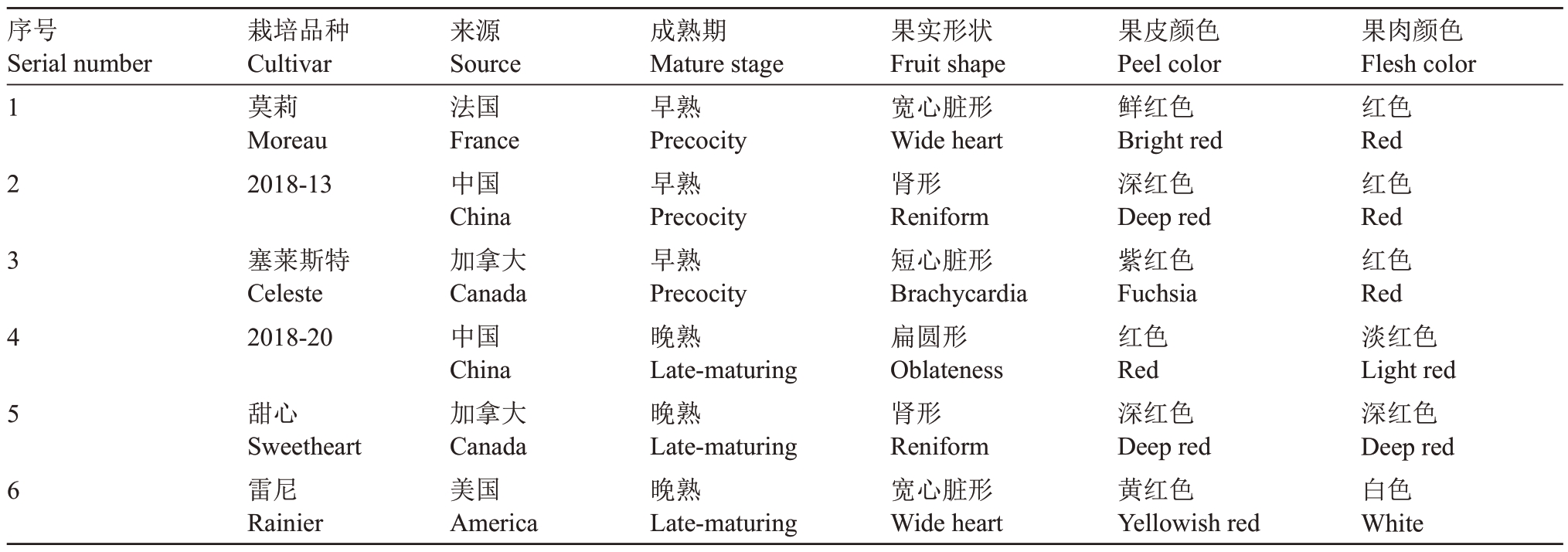
序号Serial number 1 2 3 4 5 6栽培品种Cultivar莫莉Moreau 2018-13塞莱斯特Celeste 2018-20甜心Sweetheart雷尼Rainier来源Source法国France中国China加拿大Canada中国China加拿大Canada美国America成熟期Mature stage早熟Precocity早熟Precocity早熟Precocity晚熟Late-maturing晚熟Late-maturing晚熟Late-maturing果实形状Fruit shape宽心脏形Wide heart肾形Reniform短心脏形Brachycardia扁圆形Oblateness肾形Reniform宽心脏形Wide heart果皮颜色Peel color鲜红色Bright red深红色Deep red紫红色Fuchsia红色Red深红色Deep red黄红色Yellowish red果肉颜色Flesh color红色Red红色Red红色Red淡红色Light red深红色Deep red白色White
1.2 方法
采用顶空固相微萃取-气相色谱-质谱联用技术(headspace solid-phase microextraction-gas chromatography-mass spectrometry,HS-SPME-GC-MS)测定香气物质含量。取10 g 樱桃果实冷冻研磨成粉末,加入10 μL 2-壬酮(8.22 mg·L-1)作为内标物、2 g NaCl 和磁力转子置于30 mL 顶空瓶中,45 ℃平衡60 min,将老化后的长度为2 cm、厚度为50/30 μm的DVB/CAR/PDMS 萃取头插入顶空瓶置于液面上方1.5 cm处,42 ℃吸附40 min,然后将SPME萃取头拔出插入GC-MS进样口,250 ℃热解吸10 min后测定香气物质含量。
GC-MS 条件:HP-5MS 毛细管色谱柱(30 mm×0.25 mm,0.25 μm);载气为高纯氦气(He>99.999%),流速1 mL·min-1。固相微萃取手动进样,不分流进样,进样口温度250 ℃,热解吸时间8 min。离子能量为70 eV,质量扫描范围45~450 m·z-1。
1.3 测定指标
1.3.1 果实品质测定 参照田彦龙等[18]的方法,测定单果质量、带果皮硬度、去果皮硬度和果形指数。
1.3.2 香气物质鉴定 基于NIST2017 标准谱库中匹配的质谱数据,仅报道正反匹配度均大于200 的结果。
1.3.3 定量分析 本研究中使用的所有标准品均用乙醇稀释至一定浓度。通过添加2-壬酮作为内标对样品中香气物质进行定量测定。各香气成分质量分数(μg·g-1)=[各成分的峰面积/(内标的峰面积×样品质量(g)]×内标质量浓度(μg·μL-1)×内标体积(μL)[19]。
1.4 统计分析
采用SPSS26.0软件进行统计分析,数据显示为平均值±标准差( )(n=3)。采用Duncan新复极差法进行差异显著性多重比较,并利用MetaboAnalyst5.0 进行主成分分析及偏最小二乘-判别(PLSDA)分析。利用TBtools 绘制热图。由GraphPad prism 9.5.0 生成箱线图和条形图。p<0.05 表示差异有统计学意义。
)(n=3)。采用Duncan新复极差法进行差异显著性多重比较,并利用MetaboAnalyst5.0 进行主成分分析及偏最小二乘-判别(PLSDA)分析。利用TBtools 绘制热图。由GraphPad prism 9.5.0 生成箱线图和条形图。p<0.05 表示差异有统计学意义。
2 结果与分析
2.1 6个甜樱桃品种果实生长发育调查
莫莉、2018-13、塞莱斯特、2018-20、甜心、雷尼的生长和发育情况如图2 所示。随着甜樱桃的发育,果实质量逐渐增加,带果皮硬度和果肉硬度在着色期迅速降低,然后呈小范围波动,而果形指数呈W 形波动。在完熟期(RP),2018-20、2018-13、塞莱斯特的果实质量显著高于雷尼(p<0.05,图2-A);塞莱斯特、2018-20的带果皮硬度和果肉硬度显著高于其他4 个品种(p<0.05,图2-B、C);6 个品种果形指数(0.80~0.95)间差异不显著(图2-D),这表明6个品种果实形状为近圆形或椭圆形,品质均较好,具有可比性。
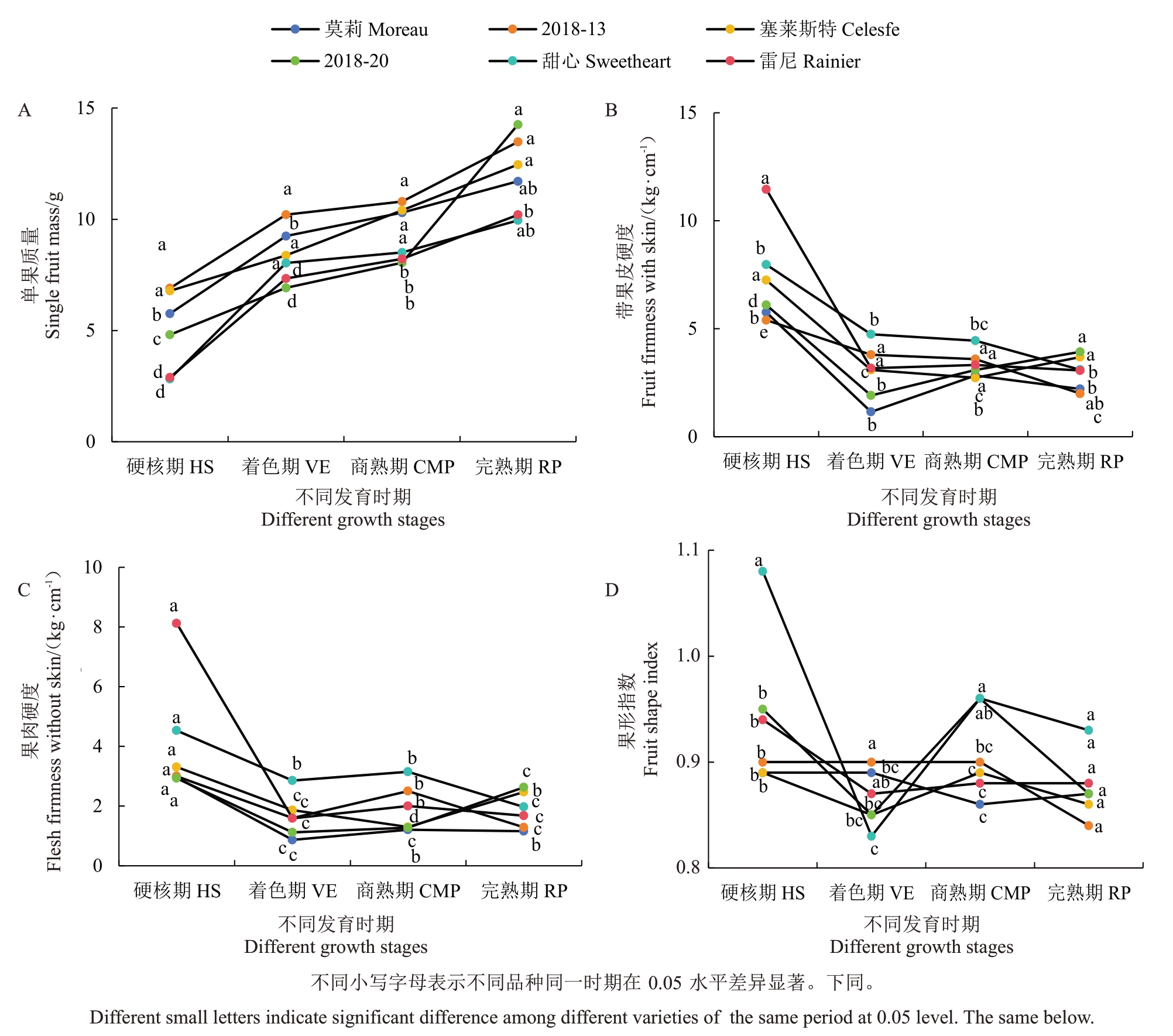
图2 不同发育时期莫莉、2018-13、塞莱斯特、2018-20、甜心、雷尼的果实品质
Fig.2 Fruit quality of Moreau,2018-13,Celeste,2018-20,Sweetheart and Rainier
2.2 6个甜樱桃品种果实不同发育时期各香气成分种类及含量的动态变化
6 个甜樱桃品种果实发育过程中,共检测到17种醛类、23种醇类、37种烷烃类、17种烯烃类、5种酯类、3 种酮类、2 种呋喃类、4 种酸类,共8 类108 种香气物质。其中,在HS、VE、CMP、RP 分别检出69、46、45、32 种香气物质。在果实生长发育过程中含量较高且随着果实生长发育含量有明显变化的香气物质有4 类,分别为醛类、醇类、烷烃类、烯烃类,因此对这4类香气物质进行分析。
结果显示,从HS 期到PR 期,6 个甜樱桃品种均以醛类物质为主(图3)。在HS 期,莫莉醛类含量显著高于其他品种;在VE 期,甜心醛类含量达23 832.97 μg·kg-1,显著高于其他品种;在CMP期,甜心醛类含量显著低于其他品种;在RP期,2018-20醛类含量最低,显著低于其他品种(图3-A)。在醇类含量方面,在HS期,塞莱斯特含量显著高于其他品种;在VE期,甜心含量显著高于其他品种,莫莉含量最低;在RP期,雷尼醇类含量最高达2 947.88 μg·kg-1,显著高于其他品种(图3-B)。在烯烃类含量方面,在RP期6个品种的含量均无;在HS期,甜心含量最高达337.39 μg·kg-1,显著高于其他品种(图3-C)。在烷烃类含量方面,在HS期6个品种的含量相对较高,2018-13含量显著高于其他品种,在PR期烷烃类含量在0.81~560.64 μg·kg-1之间,波动最大,其中雷尼含量显著高于其他品种(图3-D)。
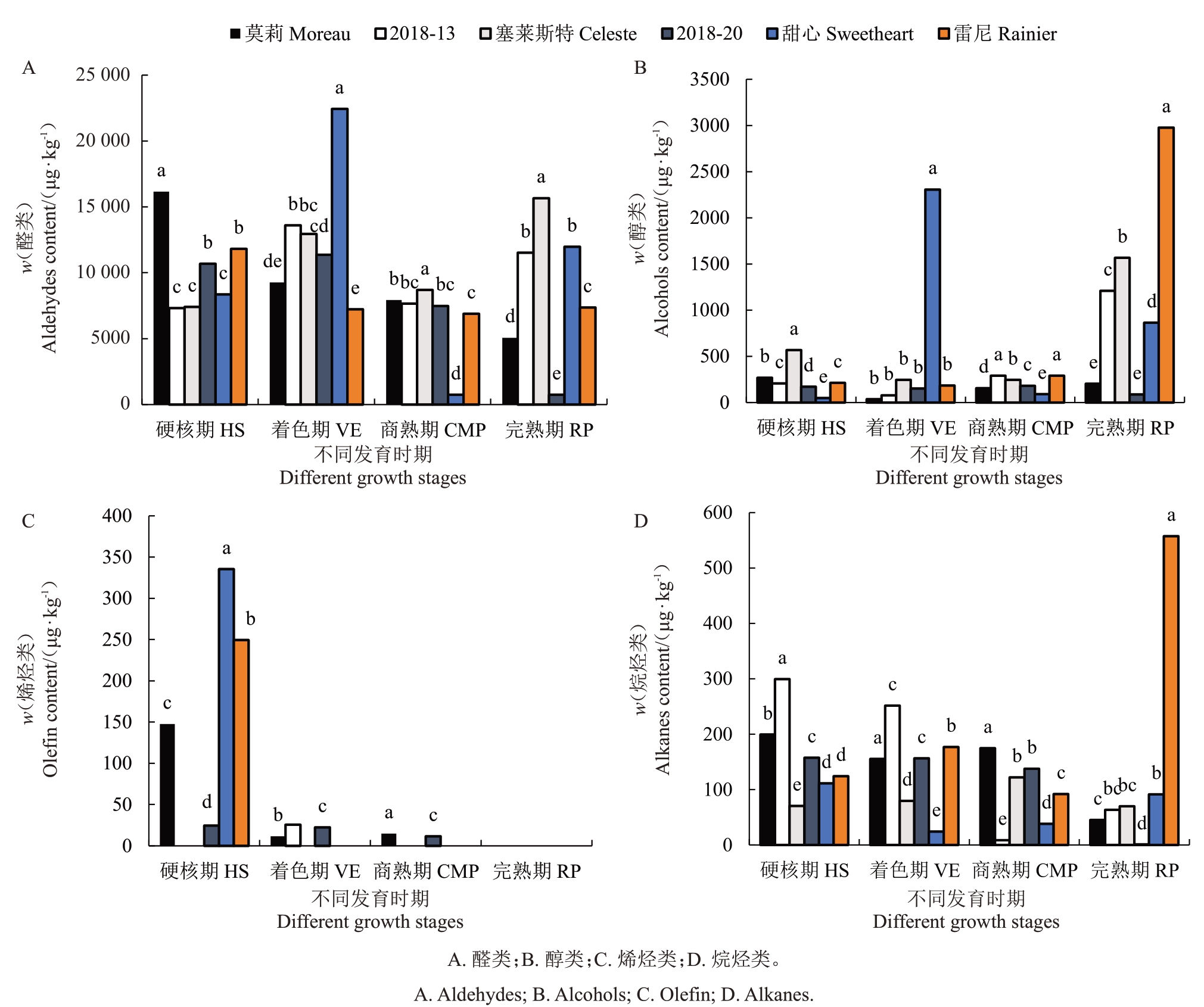
图3 6 个甜樱桃品种果实不同发育时期香气物质含量的动态变化
Fig.3 Dynamic changes of aroma substance contents in 6 sweet cherry varieties at different developmental stages
随着甜樱桃的生长发育,莫莉品种醛类物质含量大致呈逐渐降低的趋势,2018-13品种中醛类物质含量大致呈先升高后下降然后再升高的趋势,塞莱斯特品种中醇类物质含量呈先下降后升高的趋势;2018-20品种中烯烃类含量呈逐渐下降的趋势至PR期达最低;甜心品种中醛类和醇类含量均呈升高后下降然后再升高的趋势;而雷尼品种中烷烃类含量呈先升高后下降然后再升高的趋势至RP 含量达高峰。以上结果说明6个甜樱桃品种果实发育过程中香气物质含量的动态变化各有差异。
2.3 6个甜樱桃品种果实不同发育时期香气物质韦恩图分析
维恩图能可视化地展现6个甜樱桃品种不同时期挥发性香气物质的分布情况。由图4可知,从HS期到RP 期,香气组分呈现逐渐下降的趋势,各时期有14 种共有组分,分别为:反式-2-己烯-1-醇、1-己醇、己醛、2-己烯醛、反式-2-己烯醛、庚醛、苯甲醛、辛醛、壬醛、癸烷、4-甲基癸烷、4,7-二甲基十一烷、2-甲基壬烷、甲基庚烯酮,分别占各自总香气组分的20.29%、30.43%、31.11%、43.75%。在HS时期,共有组分占总香气组分的比例最低,在VE、CMP时期共有组分占总香气组分的比例相差不大;在HS、VE、CMP、RP 各自独有的组分分别有42、9、13、5 种,分别占各自总风味组分的60.87%、19.57%、20.00%、15.63%,这说明在VE、CMP时期挥发性香气成分具有更高的相似性,而HS 样品风味物质更为丰富,这些特有的组分赋予了样品独特的风味。甜樱桃品种香气不是某一类物质单独作用的结果,这些挥发性香气成分间相互作用,使得甜樱桃的香气更加丰富和协调。
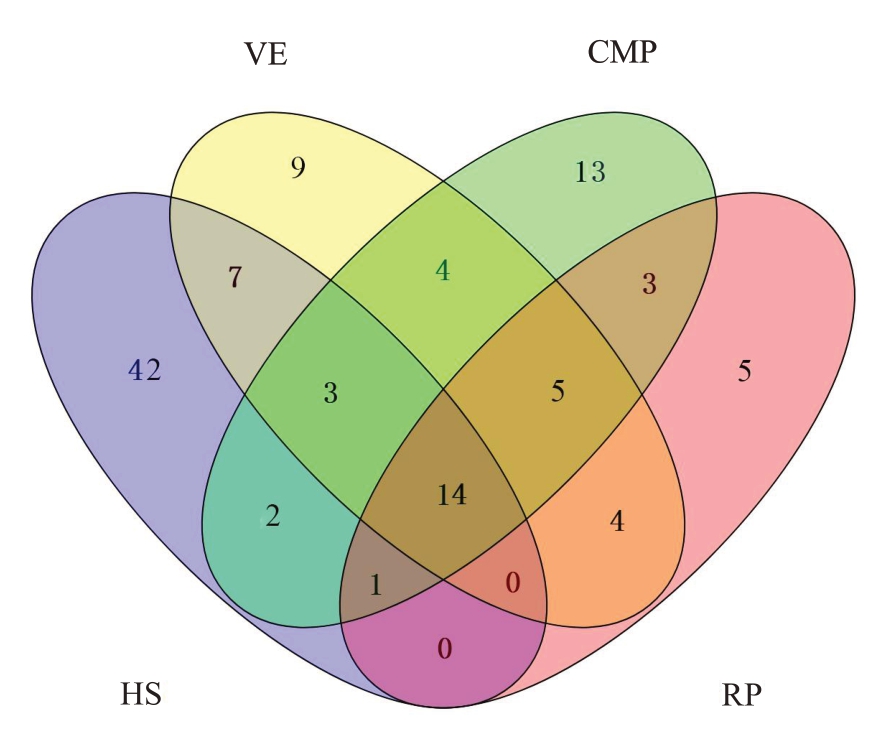
图4 6 个甜樱桃品种果实不同发育时期香气物质种类韦恩图
Fig.4 Total Venn diagram of aroma substances in 6 sweet cherry varieties at different developmental stages
2.4 6个甜樱桃品种果实不同发育时期香气物质含量变化热图分析
TBtools 是一种用于高通量数据分析的小工具[20]。利用TBtools 绘制热图(图5),可以直观地比较14 种共有香气组分含量的变化。如图5 所示:色阶颜色从粉色到红色的变化代表了相对含量从低到高,可以观察到,在4 个发育时期,反式-2-己烯醛的含量较高,其次为2-己烯醛、己烯醛、反式-2-己烯-1-醇。2-己烯醛在发育早期处于较低水平,在成熟阶段达到最大值。
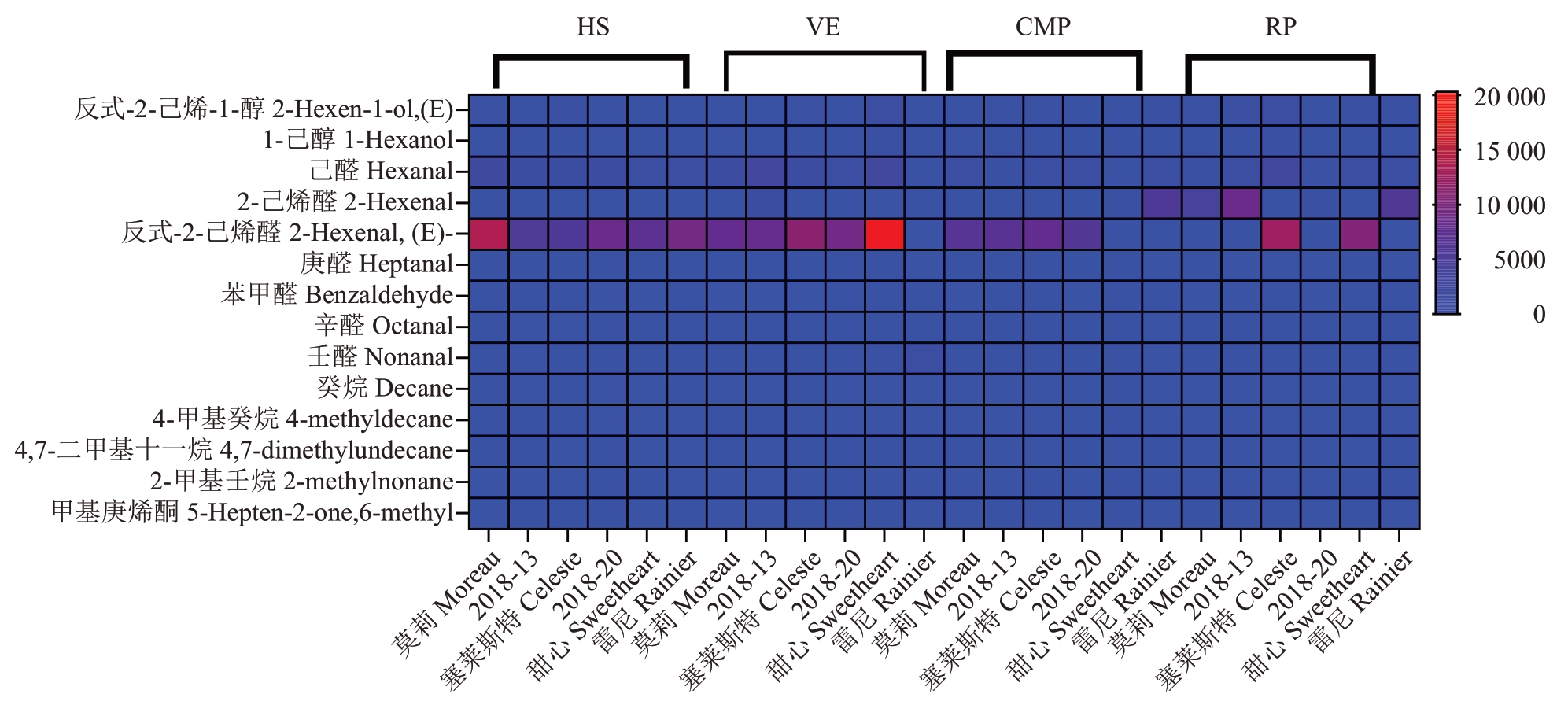
图5 6 个甜樱桃品种果实不同发育时期香气物质含量变化热图
Fig.5 Heat map of changes of aroma substance content in fruits of 6 sweet cherry varieties at different developmental stages
2.5 6 个甜樱桃品种果实不同发育时期香气物质PCA分析
主成分分析是一种可直观反映样本成分之间关联的统计方法,不同样品之间的距离越远,表明其风味差异越明显,样品的分布区域和某种挥发性风味物质的分布越接近,说明该物质对风味贡献越大[21]。
从图6可以看出,在共检测出的108种香气物质中有94种物质在不同品种间变异大,故不进行主成分分析,仅将6个甜樱桃品种样品中4个时期均检测到的14种共有香气物质进行主成分分析,并提取前两个主成分作图,累计贡献率占总变量的50.6%,结果见图6。不同时期甜樱桃品种的香气成分分布在不同的象限内,表明他们在香气成分上存在一定的差异性。甜心位于第1 象限,在RP 期和VE 期与其密切的香气物质是反式-2-己烯-1-醇、苯甲醛、1-己醇、辛醛、6-甲基-5-庚烯-2-酮;雷尼位于第2象限,从VE 期到CMP 期再到PR 期与其密切相关的香气物质是2-己烯醛、2-甲基辛醛、壬烷;莫莉位于第3 象限,在HS 期、VE 期及CMP 期与其密切相关的香气物质是癸烷、4,7-二甲基十一烷、4-甲基癸烷。
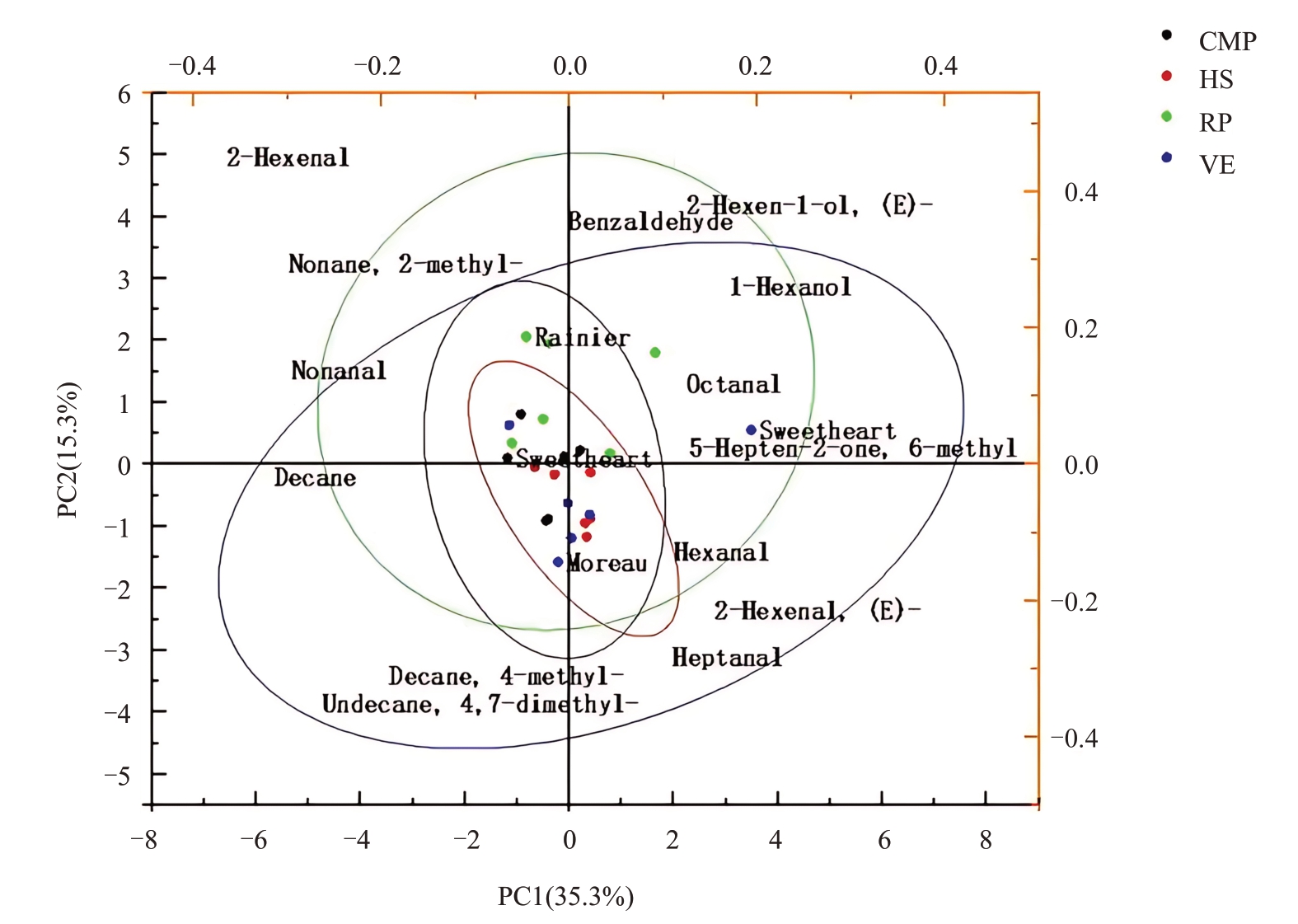
图6 6 个甜樱桃品种果实发育时期前两个主成分的散点图
Fig.6 Scatter plots of the first two principal components of six sweet cherry varieties during fruit development
2.6 6个甜樱桃品种果实不同发育时期香气物质的PLS-DA分析
PLS-DA 是一种具有监督性的判别分析方法,一般用于两组及两组以上组别的对比,用于寻找差异物质[22]。在PLS-DA 模型判别过程中一般认为VIP>1,表示其为主要差异香气物质[23],可以作为不同发育时期香气物质变化的关键性成分。VIP值越大,说明该组分在不同发育时期中的差异越显著。VIP值大于1的物质如反式-2-己烯醛、2-己烯醛、己醛、反式-2-己烯-1-醇为主要差异香气物质(图7)。在HS 期果实香气成分中,反式-2-己烯醛、己醛、甲基庚烯酮、庚醛、4-甲基癸烷、癸烷和辛醛含量较高,在VE 期的果实香气成分中,反式-2-己烯醛、己醛、壬醛、4,7-二甲基十一烷、甲基庚烯酮、癸烷和辛醛含量较高;在CMP 期的果实香气成分中,2-甲基壬烷、4-甲基癸烷含量较高;在RP 期的果实香气成分中,2-己烯醛、反式-2-己烯-1-醇、苯甲醛、1-己醇及庚醛含量较高。
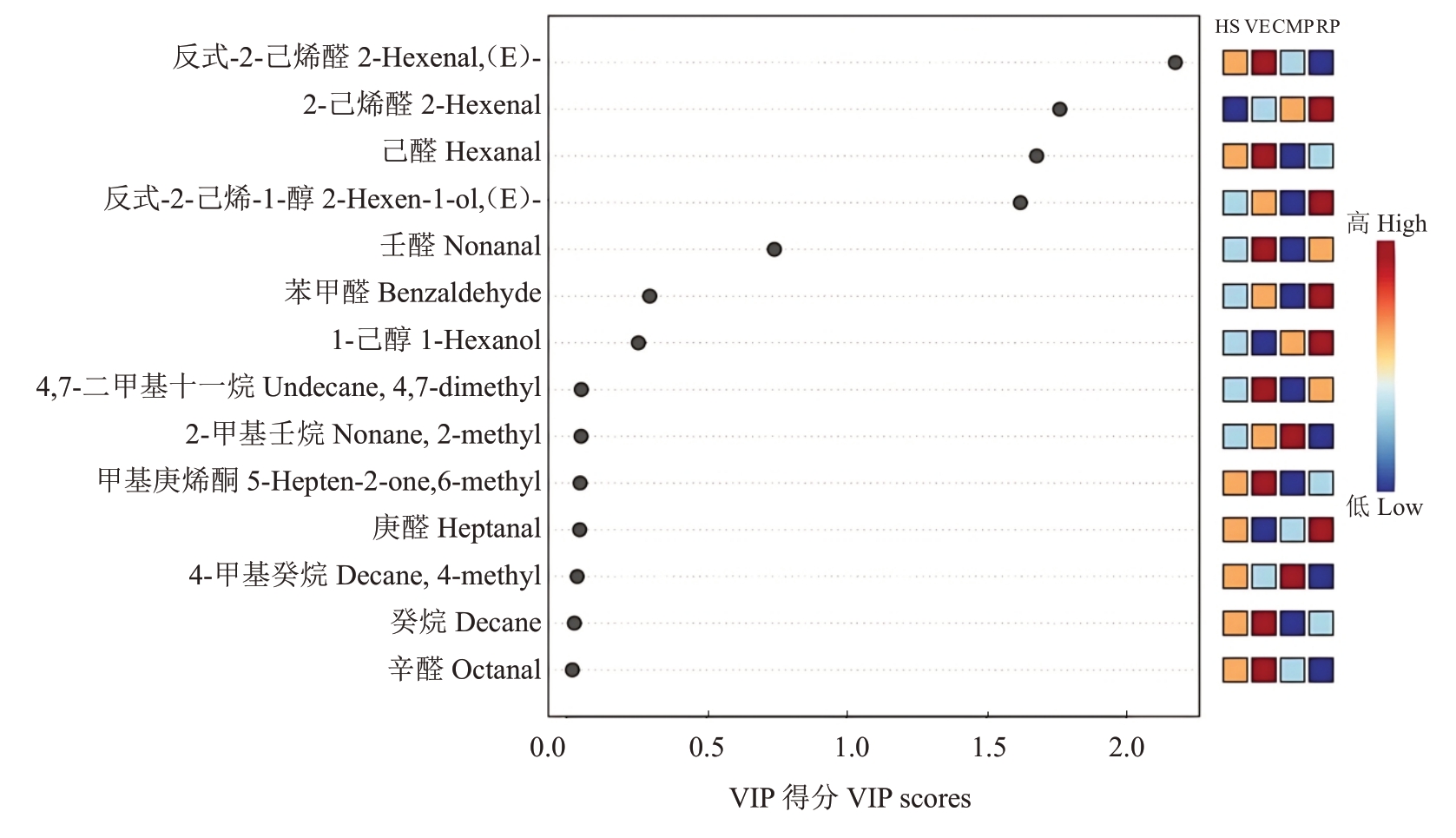
图7 6 个甜樱桃品种不同发育时期香气化合物偏最小二乘-判别分析
Fig.7 Partial least squares discriminant analysis of aroma compounds in 6 sweet cherry cultivars at different developmental stages
进一步分析6 个甜樱桃品种果实不同发育时期差异香气物质在发育过程中的变化,从图8-A 可知,在果实发育过程中,反式-2-己烯醛在塞莱斯特和甜心中含量呈先升高后降低再升高的趋势,而莫莉和雷尼则一直呈下降趋势,2018-13 和2018-20 呈先升高后降低的趋势。从图8-B 可知,莫莉、2018-20 和雷尼3 个甜樱桃品种在果实发育过程中2-己烯醛的含量呈先降低后升高的变化趋势,2018-13和塞莱斯特呈先升高后降低再升高的变化趋势,而甜心呈先降低后升高再降低的变化趋势。从图8-C可知,在果实发育过程,2018-13、塞莱斯特和甜心的己醛含量呈先升高后降低再升高的变化趋势,莫莉和2018-20 呈一直下降的趋势,雷尼呈先降低后升高的变化趋势。从图8-D可知,莫莉、2018-13、塞莱斯特和雷尼4 个甜樱桃品种在果实发育过程中反式-2-己烯-1-醇含量呈先降低后升高的变化趋势,2018-20 呈先降低后升高再降低的变化趋势,而甜心呈先升高后降低再升高的变化趋势。以上结果说明6 个甜樱桃品种不同发育时期差异香气物质的动态变化各有差异。。

图8 6 个甜樱桃品种不同发育时期反式-2-己烯醛、2-己烯醛、己醛、反式-2-己烯-1-醇含量的变化
Fig.8 Content changes of 2-Hexenal,(E)-,2-Hexenal,Hexanal,2-Hexen-1-ol,(E)-in 6 sweet cherry varieties at different developmental stages
3 讨 论
3.1 6个甜樱桃品种不同时期的香气特征
甜樱桃香气物质主要存在于果实、花和叶片中,由100多种有机成分混合形成[24],主要包括醛类、醇类、酯类、烷烃类、酮类、烯烃类等,香气物质是评价甜樱桃果实重要的特征品质指标[25]。张序等[26]在红灯甜樱桃发育进程中共检测到37种香气成分,其中己醛、(E)-2-己烯醛、苯甲醛、(E)-2-己烯醇、乙酸乙酯、己酸乙酯是甜樱桃成熟果实的特征香气成分。田竹希[16]研究发现,在玛瑙红樱桃不同发育阶段共检测出114 种物质,在绿熟期、着色期、商熟期和完熟期分别检出79、77、44 和53 种香气物质。本研究发现,6 个甜樱桃品种在4 个发育时期,均表现出富含反式-2-己烯醛的特征,反式-2-己烯醛占总香气物质的63.32%,另外己烯醛占14.69%,这与前人研究结果基本一致[27]。在6个甜樱桃品种果实发育过程中,共检测到108 种香气物质,在HS、VE、CMP、RP 4 个时期有14 种共有组分,甜樱桃的挥发性特征显示出品种之间的共性[28-29],本研究结果与之一致。
3.2 6个甜樱桃品种香气物质在不同发育时期的动态变化
果实生长发育成熟过程是一个糖酸代谢、细胞壁代谢、色素代谢、能量代谢等多个生物学途径交叉的复杂过程[30],大多数挥发性成分是在成熟后至收获期间产生的,而一些香气化合物则在成熟前产生[31]。Cui等[32]对3个矮樱桃品种成熟过程中的挥发性成分进行了动态评价,共检测出164 种挥发性成分。在成熟过程的早期阶段,未成熟的果实含有丰富的醛类、烷烃类、烯烃类。随着果实的发育成熟,酯类化合物和萜类化合物占主导地位。另有研究报道,甜樱桃成熟过程中只有少数挥发性化合物对果实香气有实质性贡献,大多数是酯类、醇类、醛类等[33]。本研究发现,在所检测的4 个发育期含量较高且随着果实生长发育含量有明显变化的香气物质有醛类、醇类、烷烃类、烯烃类。从HS 期到PR期,6 个甜樱桃品种均以醛类物质为主,与斯坦勒樱桃、先锋樱桃和红灯樱桃等一致[34-35]。另外,莫莉品种醛类物质含量大致呈现逐渐降低的趋势,2018-13 品种中醛类物质含量大致呈先升高后下降然后再升高的趋势,塞莱斯特品种中醇类物质含量呈先下降后升高的趋势;2018-20 品种中烯烃类含量呈逐渐下降的趋势至PR 期达最低;甜心品种中醛类和醇类均呈先升高后下降然后再升高的趋势;而雷尼品种中烷烃类含量呈先升高后下降然后再升高的趋势至RP 含量达高峰。说明6 个甜樱桃品种间香气物质含量的动态变化有不同程度的差异,分析其原因可能与甜樱桃品种遗传多样性有关。研究表明,在脂氧合酶(LOX)基因家族中,PaLOX2、PaLOX5、PaLOX10、PaLOX7、PaLOX11 和PaLOX12 对甜樱桃的成熟和挥发性成分有重要影响[18]。另有研究发现,不同甜樱桃品种间香气物质含量的差异对区分果实来源(遗传或地理)具有一定的价值[36]。
3.3 甜樱桃香气物质不同发育时期主成分分析
利用Venn图聚类分析发现,在4个发育时期,与甜樱桃品种密切相关的共有香气物质有14 种:反式-2-己烯-1-醇、1-己醇、己醛、2-己烯醛、反式-2-己烯醛、庚醛、苯甲醛、辛醛、壬醛、癸烷、4-甲基癸烷、4,7-二甲基十一烷、2-甲基壬烷、6-甲基-5-庚烯-2-酮。研究表明,醛类、醇类和烷烃类是甜樱桃发育过程中独特香气的主要贡献者[37],与本研究结果一致。另有研究报道醛类和醇类也是西瓜[38]、甜瓜[39]果实香气的主要物质。在果实发育过程中,各香气组分的变化既受到内源基因的调控,又受到自然因素及栽培措施的影响[40]。在草莓中,高架基质栽培方式下红颜果实γ-癸内酯和天使8号果实5-二甲基-3(2H)-呋喃酮(DMMF)及4-甲氧基-2的相对含量明显高于常规土壤栽培方式,也保持了草莓果实成熟后主要挥发性香气物质的稳定性,提升了果实的果香、甜香味[41]。在甜樱桃成熟和采收期间,由于高浓度醛的影响,甜樱桃香气物质含量的产生晚于颜色变化,进而导致成熟不同步[18]。本研究发现,不同时期甜樱桃品种的香气成分分布在不同的象限内,表明他们在香气成分上存在一定的差异性。甜心位于第1 象限,在RP 期及VE 期与其密切相关的香气物质是反式-2-己烯-1-醇、苯甲醛、1-己醇、辛醛、6-甲基-5-庚烯-2-酮;雷尼位于第2象限,从VE期到CMP期再到PR期与其密切相关的香气物质是2-己烯醛、2-甲基辛醛、壬醛;莫莉位于第3 象限,在HS 期、VE期及CMP期与其密切相关的香气物质是癸烷、4,7-二甲基十一烷、4-甲基癸烷。这可能是甜樱桃品种差异及各品种所含香气物质种类不同所致[42]。
3.4 甜樱桃香气物质不同发育时期偏最小二乘判别分析
甜樱桃基因组的研究有助于识别影响水果质量的信号转导和代谢途径。目前发现脂氧合酶(LOX)、醇酰基转移酶(AAT)、乙醇脱氢酶(ADH)和O 一甲基转移酶(OMT)基因与果实香气合成有关[43]。研究发现,在甜樱桃成熟过程中香气物质的变化与LOX 途径基因家族不同成员的表达模式存在的差异有关[18]。在葡萄的研究中发现,轻中度水分胁迫处理可增加赤霞珠葡萄果实部分挥发性化合物的种类和含量,促进VvCCD1、VvEcar、VvHPLA、Vvlis等基因的表达[44]。笔者利用偏最小二乘判别分析,筛选出VIP 值大于1 的物质,发现反式-2-己烯醛、2-己烯醛、己醛、反式-2-己烯-1-醇为主要差异香气物质,这与多项研究的结果一致[13,29,42]。6 个甜樱桃品种不同发育时期香气物质的动态变化各有差异。分析可能的原因是甜樱桃成熟过程中香气物质的动态变化与基因调节有关。研究发现,在甜樱桃LOX 基因中,PaLOX2、PaLOX5、PaLOX10、PaLOX7、PaLOX11 和PaLOX12 对甜樱桃的成熟和挥发性成分有重要影响[18],这些基因可能对果实成熟过程中细胞扩增的生理变化具有调节作用[45]。总之,甜樱桃在不同发育时期香气物质的变化受多种因素的影响。其中,基因型是造成香气物质变化和含量差异的主要原因。不同品种甜樱桃的香气代谢途径也存在差异,需要进一步研究。随着基因组学、蛋白质组学和代谢组学的发展,可以对甜樱桃发育不同时期香气物质合成代谢的具体途径和关键基因进行研究。
4 结 论
甜樱桃果实发育过程中不同品种香气物质的动态变化各有差异,这可能是甜樱桃品种差异及品种所含香气物质种类不同所致。在6 个甜樱桃品种中,反式-2-己烯醛、2-己烯醛、己醛、反式-2-己烯-1-醇为关键香气成分,这为甜樱桃优良品种的香味遗传育种和香气合成代谢及分子生物学研究提供了理论依据。
[1] WU Y J,SONG Q Q,YUAN Y,GUO F Q,WU K X,DONG M M.In vitro efficiency of embryo rescue of intra-and interspecific hybrid crosses of sweet cherry and Chinese cherry cultivars[J].Scientia Horticulturae,2021,275:109716.
[2] 李玉生,吴永杰,陈龙,赵艳华,吴雅琴,程和禾.不同砧木对甜樱桃红灯生长、产量及果实品质的影响[J]. 南方农业学报,2021,52(4):1073-1081.LI Yusheng,WU Yongjie,CHEN Long,ZHAO Yanhua,WU Yaqin,CHENG Hehe. Effects of different rootstocks on the growth,yield and fruit quality of sweet cherry Hongdeng[J].Journal of Southern Agriculture,2021,52(4):1073-1081.
[3] 管理平,王兴辉,马进伟.乐都甜樱桃免受冻害的温度保证率分析[J].青海农林科技,2020(2):36-39.GUAN Liping,WANG Xinghui,MA Jinwei.Analysis of temperature guarantee rate of Ledu district sweet cherry from freezing injury[J]. Science and Technology of Qinghai Agriculture and Forestry,2020(2):36-39.
[4] 李明,赵改荣,刘聪利,李玉红.国内外欧洲甜樱桃主产区生态气候比较与分析[J].果树学报,2014,31(增刊1):169-174.LI Ming,ZHAO Gairong,LIU Congli,LI Yuhong. Comparative analysis on ecological and climatic factors of the sweet Cherry main production area at home and abroad[J]. Journal of Fruit Science,2014,31(Suppl.1):169-174.
[5] KLEE H J,TIEMAN D M. The genetics of fruit flavour preferences[J].Nature Reviews Genetics,2018,19(6):347-356.
[6] GAO C C,ZHANG Y,LI H M,GAO Q,CHENG Y D,OGUNYEMI S O,GUAN J F.Fruit bagging reduces the postharvest decay and alters the diversity of fruit surface fungal community in‘Yali’pear[J].BMC Microbiology,2022,22(1):239.
[7] SPAHO N,GAŠI F,LEITNER E,BLESIĆ M,AKAGIĆ A,ŽULJEVIĆ S O,KURTOVIĆ M,RATKOVIĆ D Đ,MURTIĆ M S,AKŠIĆ M F,MELAND M. Characterization of volatile compounds and flavor in spirits of old apple and pear cultivars from the Balkan region[J].Foods,2021,10(6):1258.
[8] LI X J,QI L Y,ZANG N N,ZHAO L H,SUN Y Q,HUANG X T,WANG H Y,YIN Z P,WANG A D. Integrated metabolome and transcriptome analysis of the regulatory network of volatile ester formation during fruit ripening in pear[J].Plant Physiology and Biochemistry,2022,185:80-90.
[9] 赵子贤,杨金雨,汪梦诗,魏梦媛,马婷婷,房玉林,孙翔宇.12种国产主栽猕猴桃品种果酒风味物质特征分析[J/OL].食品科学,2025:1-33.(2025-01-23)[2025-02-18]. https://link.cnki.net/urlid/11.2206.ts.20250122.1517.012.ZHAO Zixian,YANG Jinyu,WANG Mengshi,WEI Mengyuan,MA Tingting,FANG Yulin,SUN Xiangyu.Characterisation of flavouring substances in fruit wines from 12 domestically grown kiwifruit varieties[J/OL].Food Science,2025:1-33.(2025-01-23)[2025-02-18].https://link.cnki.net/urlid/11.2206.ts.20250122.1517.012.
[10] 冯丹萍,何荣荣,程思琦,孙悦.本土酵母NX11424 对赤霞珠葡萄酒发酵中酵母菌多样性及香气成分的影响[J].微生物学通报,2022,49(9):3722-3739.FENG Danping,HE Rongrong,CHENG Siqi,SUN Yue. Effects of indigenous yeast NX11424 inoculation on the yeast diversity and aroma compounds during Cabernet Sauvignon wine fermentation[J].Microbiology China,2022,49(9):3722-3739.
[11] GONÇALVES A C,CAMPOS G,PINTO E,OLIVEIRA A S,ALMEIDA A,DE PINHO P G,ALVES G,SILVA L R. Essential and non-essential elements,and volatile organic compounds for the discrimination of twenty-three sweet cherry cultivars from Fundão,Portugal[J].Food Chemistry,2022,367:130503.
[12] MAGRI A,MALORNI L,COZZOLINO R,ADILETTA G,SIANO F,PICARIELLO G,CICE D,CAPRIOLO G,NUNZIATA A,DI MATTEO M,PETRICCIONE M. Agronomic,physicochemical,aromatic and sensory characterization of four sweet cherry accessions of the Campania region[J]. Plants,2023,12(3):610.
[13] 王登亮,孙建城,刘春荣,郑雪良,查波.大棚设施栽培对柑橘香气成分的影响[J].浙江农业科学,2020,61(9):1791-1794.WANG Dengliang,SUN Jiancheng,LIU Chunrong,ZHENG Xueliang,ZHA Bo. Effects of greenhouse facility cultivation on aroma components of Citrus[J]. Journal of Zhejiang Agricultural Sciences,2020,61(9):1791-1794.
[14] 张序,李延菊,孙庆田,张福兴.不同品种甜樱桃果实芳香成分的GC-MS 分析[J].果树学报,2014,31(增刊1):134-138.ZHANG Xu,LI Yanju,SUN Qingtian,ZHANG Fuxing. GCMS analysis of aroma components in sweet cherry (Prunus avium) cultivars[J]. Journal of Fruit Science,2014,31(Suppl. 1):134-138.
[15] CORREIA S,SCHOUTEN R,SILVA A P,GONÇALVES B.Factors affecting quality and health promoting compounds during growth and postharvest life of sweet cherry (Prunus avium L.)[J].Frontiers in Plant Science,2017,8:2166.
[16] 田竹希,龙明秀,李咏富,何扬波,梁倩,石彬,罗其琪.玛瑙红樱桃果实不同发育阶段香气成分分析[J]. 食品工业科技,2022,43(7):333-342.TIAN Zhuxi,LONG Mingxiu,LI Yongfu,HE Yangbo,LIANG Qian,SHI Bin,LUO Qiqi. Study on aroma constituents of Manaohong cherry cultivar at different development stages[J].Science and Technology of Food Industry,2022,43(7):333-342.
[17] VILLAVICENCIO J D,TOBAR J,ZOFFOLI J P,O’BRIEN J A,CONTRERAS C.Identification,characterization,and expression of lipoxygenase genes in sweet cherry (Prunus avium L.)cv.Regina and their relationship with the development of an herbaceous off-flavor during fruit ripening[J].Plant Physiology and Biochemistry,2024,206:108271.
[18] 田彦龙,马永强,王磊,郭青云,陈红雨.西北不同生态区甜樱桃果实品质分析[J].果树学报,2021,38(4):509-519.TIAN Yanlong,MA Yongqiang,WANG Lei,GUO Qingyun,CHEN Hongyu.Quality analysis of sweet cherry fruits in different ecological areas in northwest China[J]. Journal of Fruit Science,2021,38(4):509-519.
[19] 郝丽宁,陈书霞,王聪颖,陈巧,万旭花,申晓青,程智慧,孟焕文.不同基因型黄瓜果实芳香物质组成及含量差异研究[J].西北农林科技大学学报(自然科学版),2013,41(6):139-146.HAO Lining,CHEN Shuxia,WANG Congying,CHEN Qiao,WAN Xuhua,SHEN Xiaoqing,CHENG Zhihui,MENG Huanwen. Aroma components and their contents in cucumbers from different genotypes[J]. Journal of Northwest A&F University(Natural Science Edition),2013,41(6):139-146.
[20] CHEN C J,CHEN H,ZHANG Y,THOMAS H R,FRANK M H,HE Y H,XIA R. TBtools:An integrative toolkit developed for interactive analyses of big biological data[J]. Molecular Plant,2020,13(8):1194-1202.
[21] 李芳.硬脂鱼油的品质特征及在火锅底料中的应用研究[D].重庆:西南大学,2021.LI Fang. Study on the quality characteristics of fish oil stearin and its application in hotpot seasoning[D]. Chongqing:Southwest University,2021.
[22] 张纪伟,沈雪梅,张钎,周艺凡,李光秀,李家华.不同产地和贮存年份普洱生茶香气和呈味物质变化的比较研究[J].食品研究与开发,2021,42(9):11-18.ZHANG Jiwei,SHEN Xuemei,ZHANG Qian,ZHOU Yifan,LI Guangxiu,LI Jiahua. Comparative study on changes of aroma and flavor components of raw Pu-erh tea produced in different producing areas and storage years[J]. Food Research and Development,2021,42(9):11-18.
[23] 张乐,张雅,史冠莹,赵丽丽,蒋鹏飞,王旭增,王赵改.GC-IMS结合化学计量学分析8 个产区香椿挥发性成分差异[J].食品科学,2022,43(22):301-308.ZHANG Le,ZHANG Ya,SHI Guanying,ZHAO Lili,JIANG Pengfei,WANG Xuzeng,WANG Zhaogai. Differences in volatile organic compounds of to ona sinensis from eight production regions analyzed by gas chromatography-ion mobility spectrometry combined with chemometrics[J]. Food Science,2022,43(22):301-308.
[24] GONÇALVES A C,BENTO C,SILVA B,SIMÕES M,SILVA L R. Nutrients,bioactive compounds and bioactivity:The health benefits of sweet cherries (Prunus avium L.)[J]. Current Nutrition&Food Science,2019,15(3):208-227.
[25] 邱珊莲,张少平,林宝妹,张帅,洪佳敏,吴妙鸿,郑开斌.不同成熟期番石榴果实香气成分变化[J].江苏农业科学,2021,49(13):162-169.QIU Shanlian,ZHANG Shaoping,LIN Baomei,ZHANG Shuai,HONG Jiamin,WU Miaohong,ZHENG Kaibin.Changes of aroma components of guava fruits at different maturity stages[J].Jiangsu Agricultural Sciences,2021,49(13):162-169.
[26] 张序,姜远茂,彭福田,何乃波,李延菊,赵登超.‘红灯’甜樱桃果实发育进程中香气成分的组成及其变化[J].中国农业科学,2007,40(6):1222-1228.ZHANG Xu,JIANG Yuanmao,PENG Futian,HE Naibo,LI Yanju,ZHAO Dengchao. Changes of aroma components in‘Hongdeng’sweet cherry during fruit development[J]. Scientia Agricultura Sinica,2007,40(6):1222-1228.
[27] HAYALOGLU A A,DEMIR N. Phenolic compounds,volatiles,and sensory characteristics of twelve sweet cherry (Prunus avium L.) cultivars grown in Turkey[J]. Journal of Food Science,2016,81(1):C7-C18.
[28] VAVOURA M V,BADEKA A V,KONTAKOS S,KONTOMINAS M G. Characterization of four popular sweet cherry cultivars grown in Greece by volatile compound and physicochemical data analysis and sensory evaluation[J]. Molecules,2015,20(2):1922-1940.
[29] LEGUA P,DOMENECH A,MARTÍNEZ J J,SÁNCHEZ-RODRÍGUEZ L,HERNÁNDEZ F,CARBONELL-BARRACHINA A A,MELGAREJO P. Bioactive and volatile compounds in sweet cherry cultivars[J]. Journal of Food and Nutrition Research,2017,5(11):844-851.
[30] COLANTONIO V,FERRÃO L F V,TIEMAN D M,BLIZNYUK N,SIMS C,KLEE H J,MUNOZ P,RESENDE M F R Jr. Metabolomic selection for enhanced fruit flavor[J]. Proceedings of the National Academy of Sciences of the United States of America,2022,119(7):e2115865119.
[31] VILANOVA M,GENISHEVA Z,BESCANSA L,MASA A,OLIVEIRA J M. Changes in free and bound fractions of aroma compounds of four Vitis vinifera cultivars at the last ripening stages[J].Phytochemistry,2012,74:196-205.
[32] CUI Q Y,YE L Q,GUO C G,LI W D. Assessing volatiles in three Chinese dwarf cherry cultivars during veraison and maturation using headspace-solid phase microextraction with gas chromatography-mass spectrometry[J]. ACS Omega,2020,5(49):31744-31752.
[33] ESPINO-DÍAZ M,SEPÚLVEDA D R,GONZÁLEZ-AGUILAR G,OLIVAS G I. Biochemistry of apple aroma:A review[J].Food Technology and Biotechnology,2016,54(4):375-397.
[34] SUN S Y,JIANG W G,ZHAO Y P.Characterization of the aroma-active compounds in five sweet cherry cultivars grown in Yantai (China)[J]. Flavour and Fragrance Journal,2010,25(4):206-213.
[35] 邱爽,唐飞,刘畅,谢美林,魏阳吉,李景明.气相色谱-质谱联机结合感官分析共建樱桃香气关联网络[J].食品科学,2021,42(16):209-217.QIU Shuang,TANG Fei,LIU Chang,XIE Meilin,WEI Yangji,LI Jingming. Aroma networking of cherries based on gas chromatography-mass spectrometric data and sensory evaluation[J].Food Science,2021,42(16):209-217.
[36] MEDINA S,PEREIRA J A,SILVA P,PERESTRELO R,CÂMARA J S. Food fingerprints-A valuable tool to monitor food authenticity and safety[J].Food Chemistry,2019,278:144-162.
[37] COLONGES K,JIMENEZ J C,SALTOS A,SEGUINE E,LOOR SOLORZANO R G,FOUET O,ARGOUT X,ASSEMAT S,DAVRIEUX F,CROS E,LANAUD C,BOULANGER R. Integration of GWAS,metabolomics,and sensorial analyses to reveal novel metabolic pathways involved in cocoa fruity aroma GWAS of fruity aroma in Theobroma cacao[J]. Plant Physiology and Biochemistry,2022,171:213-225.
[38] 黄小忠,卢阳月,林远至,张旭淏,许鲡沣,张曼.不同瓤色西瓜果肉挥发性物质检测与分析[J].中国瓜菜,2023,36(11):33-39.HUANG Xiaozhong,LU Yangyue,LIN Yuanzhi,ZHANG Xuhao,XU Lifeng,ZHANG Man.Headspace-solid phase microextraction-gas chromatography-mass spectrometry analysis of volatile components of watermelon fruits with different flesh color[J].China Cucurbits and Vegetables,2023,36(11):33-39.
[39] 李旺雄,唐中祺,程鸿,孔维萍,罗石磊. 不同甜瓜品种贮藏期间品质变化和风味物质分析[J].中国瓜菜,2021,34(9):50-55.LI Wangxiong,TANG Zhongqi,CHENG Hong,KONG Weiping,LUO Shilei. Analysis of quality changes and flavor substances of different melon varieties during storage[J]. China Cucurbits and Vegetables,2021,34(9):50-55.
[40] 温可睿,黄敬寒,潘秋红,段长青,王军.葡萄香气物质及其影响因素的研究进展[J].果树学报,2012,29(3):454-460.WEN Kerui,HUANG Jinghan,PAN Qiuhong,DUAN Changqing,WANG Jun. Research progress of aromatic compounds and influencing factors in grapes[J]. Journal of Fruit Science,2012,29(3):454-460.
[41] 庞夫花,王庆莲,袁华招,蔡伟建,王珑静,赵密珍.不同栽培模式对草莓果实挥发性香气物质的影响[J]. 江苏农业学报,2024,40(2):359-366.PANG Fuhua,WANG Qinglian,YUAN Huazhao,CAI Weijian,WANG Longjing,ZHAO Mizhen.Effects of different cultivation modes on volatile aromatic substances of strawberry fruit[J].Jiangsu Journal of Agricultural Sciences,2024,40(2):359-366.
[42] WEN Y Q,HE F,ZHU B Q,LAN Y B,PAN Q H,LI C Y,REEVES M J,WANG J. Free and glycosidically bound aroma compounds in cherry (Prunus avium L.)[J]. Food Chemistry,2014,152:29-36.
[43] 宋丽娟,李雄伟,陈琳,柴明良,高中山.果实香气合成与遗传控制研究概述[J].果树学报,2008,25(5):708-713.SONG Lijuan,LI Xiongwei,CHEN Lin,CHAI Mingliang,GAO Zhongshan.A review on fruit aroma synthesis and its genetic control[J].Journal of Fruit Science,2008,25(5):708-713.
[44] 侯晨阳,张艳霞,薛晓斌,王振平,李栋梅.水分胁迫对‘赤霞珠’葡萄果实挥发性化合物及相关基因表达的影响[J/OL].干旱地区农业研究,2024:1-11(2024-04-02). https://kns.cnki.net/kcms/detail/61.1088.S.20240401.0941.002.html.HOU Chenyang,ZHANG Yanxia,XUE Xiaobin,WANG Zhenping,LI Dongmei. Effects of water stress on the expression of volatile compounds and related genes in‘Cabernet Sauvignon’grape berries[J/OL]. Agricultural Research in the Arid Areas,2024:1- 11(2024- 04- 02). https://kns.cnki.net/kcms/detail/61.1088.S.20240401.0941.002.html.
[45] VISWANATH K K,VARAKUMAR P,PAMURU R R,BASHA S J,MEHTA S,RAO A D. Plant lipoxygenases and their role in plant physiology[J]. Journal of Plant Biology,2020,63(2):83-95.